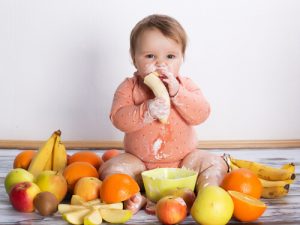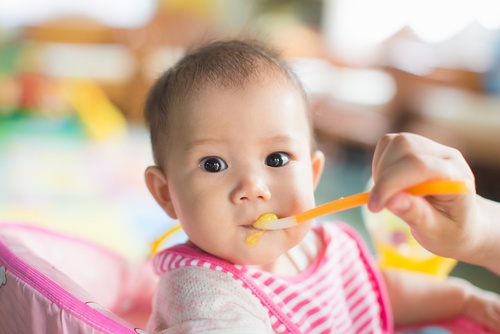The 7 Foods You Should Never Give Your Baby

During the first four months of life, your baby’s diet should be made up of milk and only milk. In some cases, babies will need feeding with formula, but the best food by far for this first stage of their life is breast milk.
However, once these first four months are over, there is a period of adaptation. During this time, children can start to eat other foods to complement their milk intake. These foods are usually simple and light, and tend to be similar in all families.
Parents can begin to complement their baby’s diet with smooth, simple, natural pastes and purees. A fruit puree is a typical meal to begin with, and other types of food can be introduced gradually.
As you do this, you should be careful that new foods are not harmful to your baby’s little body. Adjust the way you prepare food and the amount that you give to your child, so as to facilitate digestion and help them to grow.
7 foods you should never give your baby
Although it is sometimes inevitable that children eat certain kinds of food, it should be easier to control what babies eat. Parents are the ones responsible for preparing their baby’s food, so they can make sure they don’t consume anything other than milk and natural purees or pastes.
Sometimes, however, whether due to lack of knowledge or interest, we fall into feeding routines that are unhealthy for the littlest members of the family. With this in mind, it is important to know there are some foods that babies should never eat.
Like it or not, there are certain foods you should never give your baby, and that should not form part of the diet of children under 12 months old. In fact, they should be consumed only in moderation up to four years of age. We may not all be aware of these foods, but then again, there are also cases where we ignore our pediatrician’s advice.

To make sure that our little ones stay healthy, we should remember to avoid these seven products in our children’s regular diet at home. These are:
1. Sugar
Although this is very common in our food, your baby doesn’t need it. In fact, breastmilk or formula already contains enough sugar. If you want to sweeten food to improve its flavor, it’s better to do it with fruit. Sugar could give your child cavities at an early age.
2. Honey
A natural substitute for sugar, honey is common in children’s diets. However, what many people don’t know is that its composition is almost identical to that of refined sugar. Another problem is that it may contain bacteria which could harm the digestive system.
3. Salt
Just like honey and sugar, salt is used to enhance the flavor of foods, but it is also damaging. This product should not be present in a baby’s diet, as it is damaging to the health of their kidneys. It is only recommended in moderation from the age of 12 months onwards.
4. Seafood
Some types of fish and seafood contain high levels of mercury, an element that comes from pollution. It can be found in every ocean, and when fish consume it, it accumulates in their bodies.
5. Certain vegetables
Seaweed, chard, spinach and borage are high in nitrates, and when eaten in excess, they can reduce the amount of oxygen in the blood, turning into nitrites.
6. Artificial low-fat foods
It’s not a bad idea to eat foods that are unnaturally low in fat. We are talking about products made with skimmed milk, or those that have been prepared using special procedures to get rid of fat. The fat in these foods is an essential source of vitamins and calories for children’s bodies.
7. Other foods, depending on how they are prepared
There are some foods that we prepare and eat in many different ways, which can affect their properties. These are not foods that you need to eliminate completely from your baby’s diet; just avoid them in certain forms.
Avoid: raw animal products, whole dried fruits, rice-based drinks, fries, meringues, ice cream, and others.
All cited sources were thoroughly reviewed by our team to ensure their quality, reliability, currency, and validity. The bibliography of this article was considered reliable and of academic or scientific accuracy.
- Agencia de Salud Pública de Cataluña. (2022). La alimentación saludable en la primera infancia. https://salutpublica.gencat.cat/ca/ambits/promocio_salut/alimentacio_saludable/Publicacions/en-castella/
- Agencia Española de Seguridad Alimentaria y Nutrición. (s. f.). Recomendaciones de consumo para la población infantil por la presencia de nitratos en hortalizas de hoja. Consultado el 15 de mayo de 2023. https://www.aesan.gob.es/AECOSAN/web/para_el_consumidor/ampliacion/nitratos_hortalizas.htm
- Agencia Española de Seguridad Alimentaria y Nutrición. (2021, 13 de enero). La AESAN publica recomendaciones sobre el autoconsumo de carne de caza silvestre por la posible presencia de metales (plomo). https://www.aesan.gob.es/AECOSAN/web/noticias_y_actualizaciones/noticias/2021/caza_silvestre.htm
- American Academy of Pediatrics. (2021, 8 de septiembre). Healthy fish choices for kids. https://www.healthychildren.org/English/safety-prevention/all-around/Pages/Protecting-Your-Children-From-Contaminated-Fish.aspx
- American Academy of Pediatrics. (2022. 16 de agosto). La transición del bebé a los alimentos sólidos. https://www.healthychildren.org/Spanish/ages-stages/baby/feeding-nutrition/Paginas/starting-solid-foods.aspx
- Asociación Española de Pediatría. (2020, 20 de enero). Nuevas recomendaciones de consumo de pescado de la Agencia Española de Seguridad Alimentaria y Nutrición. https://www.aeped.es/comite-nutricion-y-lactancia-materna/nutricion-infantil/noticias/nuevas-recomendaciones-consumo-pescado
- Centros para el Control y la Prevención de Enfermedades. (2022. 31 de mayo). Muchos casos de botulismo son prevenibles. Departamento de Salud y Servicios Humanos de Estados Unidos. https://www.cdc.gov/botulism/prevention-es.html
- Centros para el Control y la Prevención de Enfermedades. (2022, 26 de mayo). Leche fortificada de vaca y alternativas a la leche. Departamento de Salud y Servicios Humanos de Estados Unidos. https://www.cdc.gov/nutrition/infantandtoddlernutrition/foods-and-drinks/leche-de-vaca-y-alternativas-a-la-leche.html
- Centros para el Control y la Prevención de Enfermedades. (2020, 15 de diciembre). Peligros de ahogo por atragantamiento. Departamento de Salud y Servicios Humanos de Estados Unidos. https://www.cdc.gov/nutrition/infantandtoddlernutrition/foods-and-drinks/peligros-de-ahogo-por-atragantamiento.html
- European Food Safety Authority. (2012). Cadmium dietary exposure in the European population. EFSA Journal, 10(1), 2551. https://www.efsa.europa.eu/en/efsajournal/pub/2551
- Gil-Campos, M., San José González, M. A., Díaz Martín, J. J., & Comité de Nutrición de la Asociación Española de Pediatría. (2015). Uso de azúcares y edulcorantes en la alimentación del niño. Recomendaciones del Comité de Nutricion de la Asociación Española de Pediatría. Anales de Pediatría. 83 (5): 353.e1-353.e7. https://www.analesdepediatria.org/es-uso-azucares-edulcorantes-alimentacion-del-articulo-S1695403315000739
- Hojsak, I., Braegger, Ch., Bronsky, J., Campoy, S., Colomb, V., Decsi, T., Domellöf, M., Fewtrell, M., Fidler Mis, N., Mihatsch, W., Molgaard, Ch., van Goudeveer, J., & ESPGHAN Committee on Nutrition. (2015). Arsenic in rice: a cause for concern. Journal of Pediatric Gastroenterology and Nutrition. 60 (1): 142-5. https://pubmed.ncbi.nlm.nih.gov/25536328/
- Jones, J. A., Hopper, A. O., Gordon Power, G., & Arlin Blood B. (2015). Dietary intake and bio activation of nitrite and nitrate in newborn infants. Pediatric Research. 77 (0): 173-181. https://www.ncbi.nlm.nih.gov/pmc/articles/PMC4497514/
- Korioth, T. (2019). Added sugar in kids diet’s: how much is too much? American Academy of Pediatrics. https://publications.aap.org/aapnews/news/7331?autologincheck=redirected
- Rubio, A. (2019, 1 de agosto). Los niños, la leche y los lácteos. Asociación Española de Pediatría de Atención Primaria. https://www.familiaysalud.es/vivimos-sanos/alimentacion/los-alimentos/los-ninos-la-leche-y-los-lacteos
- National Food Institute, Technical University of Denmark, Denmark, Sá Monteiro, M., Sloth, J., Holdt, S., & Hansen, M. (2019). Analysis and risk assessment of seaweed. EFSA Journal, 17, e170915. https://www.efsa.europa.eu/en/efsajournal/pub/e170915
- National Health Services. (2021, 15 de marzo). Salt, the facts. https://www.nhs.uk/live-well/eat-well/food-types/salt-nutrition/
This text is provided for informational purposes only and does not replace consultation with a professional. If in doubt, consult your specialist.
